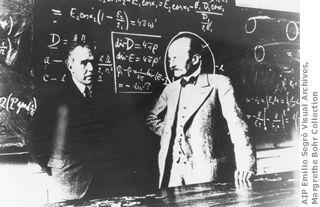| |
 |
| Bohr doubted the validity of the plantary
model of the atom as the revolving electrons would loose
energy by emitting photons and promptly fall into the
nucleus. |
 |
| Bohr suggested that only certain stable
electron orbits around the nucleus were allowed. |
|
|
|
In 1912, the Dane, Niels Bohr,
took up residence in Rutherford's laboratory in Manchester – he
was 28 years old. He immediately set about trying to understand
whether Rutherford's newly proposed 'planetary' model of
the atom was correct. He was particularly worried that the
revolving electron would radiate away its energy and fall
into the nucleus.
Continuing with the theme of quantisation started by
Planck, Bohr suggested that only certain stable electron
orbits around the nucleus were allowed. He called these,
stationary states, because electrons in these special
orbits emitted no radiation in stark contrast to the predictions
of classical physics.
 |
| Bohr and Planck standing in front
of a blackboard, 1930. |
|